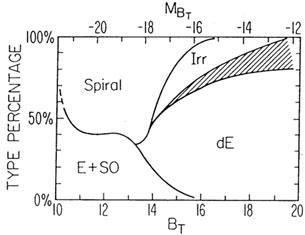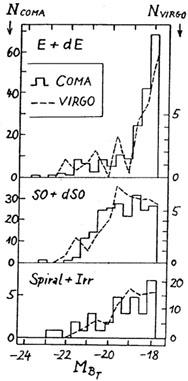


2.2 The Virgo Cluster Luminosity Function
Hubble (1936) wrote (and undoubtedly believed) that the luminosity function of galaxies was approximately Gaussian with a small dispersion of ~ 0.8 mag. Zwicky (1942, 1957, 1964) wrote (and undoubtedly hoped) that the function was exponentially increasing toward the faint end, merging smoothly from clusters of galaxies into galaxies, thence to stars, to pebbles, to grains, and then to atoms, nuclei, etc.
Both Hubble and Zwicky were right and both were wrong; each had used the same words with different meanings. Hubble's function referred to regular spirals and brightest ellipticals, all contained as the subset of a list that eventually became the Shapley-Ames catalog.
We now know that the luminosity function for spiral and E galaxies is bounded bright and faint because (1) there are no dwarf spirals, and (2) dwarf ellipticals are of a different morphological type than E galaxies. Hence, if the luminosity function is defined by a magnitude limited sample whose limit is bright, as Hubble's sample was, an upper and lower bound luminosity function is inevitable. This is due to the selection effect that causes such a sample to be giant dominated.
On the other hand, having begun to discover faint Sm and Im dwarfs (e.g., Leo A, Pegasus, Sextans A, Sextans B) - a class that was hardly known before - Zwicky made a leap of generalization which proved to be correct when the faint systems were added to the morphological mix in a volume limited sample. The shape of the luminosity function depends on the details of the mix of morphological types that are included. It is clear that differences are expected in luminosity functions of aggregates in different environments because of Dressler's morphology-density relation. This new way of looking at the luminosity function was first suggested by Tammann and Kraan (1978), discussed by Binggeli (1987), reviewed in its consequences by Binggeli, Sandage, and Tammann (1988, hereafter BST 88), and is emphasized in the remainder of this section.
Reaves (1956) was the first to write comprehensively on the existence of dwarf E galaxies in the Virgo cluster. The class had been anticipated by Baade (1944, 1950), but the sheer numbers of them in Virgo was demonstrated by Reaves. Abell (1962, 1975, Figs. 3 and 4) was the first to show the true characteristics of the "general" luminosity function integrated over all Hubble types, buttressed, to be sure, by Holmberg's (1969) suggestive study of companions to field galaxies, but few redshifts were available to him.
Figure 4 is Abell's (1975) Figure 3 from his review. The two features to note are (1) the major change of slope between the bright and faint parts of the distribution, and (2) the exponential tail at the faint end. The general shape of this distribution was parameterized by Schechter (1976). His analytical formulation, appearing more elegant than simply the two straight lines of different slope used by Abell, is now generally named the Schechter function, as we continue to do here. Nevertheless, it might have been more proper to name the shape after Abell, and the parameterization after Schechter who made the function respectable. (Abell was hardly believed in his first discussions because of the required paradigm change over the Hubble formulation and because of the similarity of Abell's result to the Zwicky conjecture - not to be believed because Zwicky was taken to be an unreliable rascal at the time).

|
Figure 4. Abell's original formulation of the cluster galaxy luminosity function based on a composite of the separate functions for four Abell clusters. The diagram is from Abell (1975). |
The Abell and/or Schechter function takes no cognizance of morphological types, hence suppressing information about the change of type as the absolute magnitude varies. The fascinating discussion by Binggeli (1987) emphasizes the consequences of hiding this information in any determination of the function that is not type-specific. Figure 5 (taken from Binggeli (1987)) shows how the important type-specific details are buried under foot if only the "universal" function has been measured.

|
Figure 5. Binggeli's (1987) illustration that the sum of individual morphological type-specific luminosity functions in Schechter's analytical approximation to the shape of Abell's "universal" function buries details under foot. |
Type-specific luminosity functions were found (Sandage, Binggeli, and Tammann 1985, hereafter SBT 85) from the Virgo cluster catalog (BST 85) for each of the major Hubble types. The "general" function shown in Figure 6 was obtained from the sum over the total cluster membership in the Virgo cluster catalog.

|
Figure 6. The "total" luminosity function obtained by summing individual type-specific luminosity functions for galaxies considered to be cluster members as listed in the Virgo Cluster Catalog (BST 85). The plots are shown in direct and log form and are from Figures 9 and 10 of SBT 85. |
The type-specific individual functions in Virgo that make up Figure 6 are shown in Figure 7, taken from Binggeli's (1987) summary. The morphological mix in the Virgo cluster is in Figure 8. It is obvious from the variation of the Hubble type with magnitude in Figure 8 why Hubble's and Zwicky's conception of the shape of the luminosity function were so different. The conclusions depend on the mix of galaxy types in the particular sample being discussed. Furthermore, because the percentage of the various types differ between high and low density regions due to the morphological-density relation, it is clear that the shape of the total luminosity function must also differ between such regions. Hence, there cannot be such a thing as the universal luminosity function.

|
Figure 7. Type-specific luminosity functions for Virgo cluster members listed in the VVC (BST 85). Diagram from Binggeli (1987). |

|
Figure 8. Variation of the percentage of Hubble types with absolute magnitude for the Virgo cluster members listed in the VVC. Diagram from SBT 85. |
This startling paradigm change was taught, I believe, first by Tammann (cf. Tammann and Kraan 1978 for literature entries on Tammann's insistent earlier theme), and also by Thompson and Gregory (1980). It is illustrated in Figure 9 due to Binggeli (1987) which shows the Coma normalization on the left and the Virgo normalization on the right for three type-specific functions. The point to note is that there are 5 times more E + dE galaxies in the high density Coma cluster compared to Virgo, yet 3 times fewer spirals + Irr types for the same comparison. This change in the ratio according to galaxy type is the expression of the morphological-density relation in Coma and Virgo. Clearly, the total luminosity function, found by summing over all Hubble types, must differ in shape according to the environment unless the type-specific functions are isomorphic.

|
Figure 9. Type-specific LFs for the Coma and the Virgo cluster member samples, showing the equality of shapes of the individual functions for each Hubble type in both clusters, but, by reading the ordinate values, showing the vastly different E/S population ratio between the clusters. Diagram from Binggeli (1987). |
This expectation of shape differences is realized in the comparison of the total luminosity function of the Virgo cluster with that of the lower density "local field", shown in Figure 10 taken from BST 88. The local field data are based on the distance-limited catalog of Kraan-Korteweg and Tammann (1979) as updated in an unpublished investigation by Kraan-Korteweg and Binggeli where the completeness of the nearby groups to MB = -15 is emphasized. The faint-end slope (Schecter's alpha parameter) clearly differs between these environments, being steeper in the cluster than in the field. We also suspect it is still steeper in the high density Coma cluster than in Virgo (Rood, 1969; Thompson and Gregory 1980).

|
Figure 10. The composite so called "general" luminosity function for the Virgo cluster and the local field sample from the 500 km s-1 distance limited catalog (updated) of Kraan-Korteweg and Tammann (1979). Diagram from BST 88. |
The two conclusions we have reached so far are (1) there is no such thing as a universal luminosity function, and (2) the ratio of giants to dwarfs differs between clusters and the field. The second conclusion, important for tests of the idea of biased galaxy formation, is treated in Section 4 where conclusions from new field surveys by Eder et al. (1989), by Schombert and Bothun (1988), and by Binggeli, Tarenghi, and Sandage (1990) are discussed.